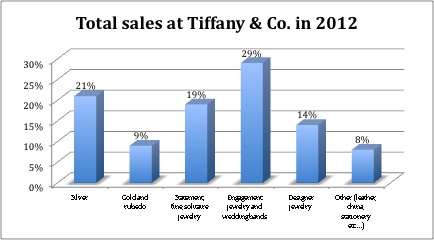Increasing silver sales is the focus for jewelry giant Tiffany & Co. this year. According to the company’s quarterly report, overall sales are up 9 per cent but silver sales are lagging.

High-end jewelry sells well, silver lags
Tiffany’s more expensive products, which are mostly necklaces and rings made of rare coloured diamonds encased in platinum, are meeting sales goals. On the other hand, silver jewelry, which makes up most of Tiffany’s cheaper products in the form of rings, necklaces and pendants, is selling poorly compared to a few years ago, according to Mark Aaron, Tiffany’s Vice-President of Investor Relations.
In an attempt to improve silver sales, the company is creating and promoting new, elaborate silver items. Some of the new products that landed on shelves this spring include the Ziegfeld collection, which contains several silver items made with freshwater pearls and onyx. Aaron says that these new products have a higher price tag than previous silver pieces. He hopes that when the second quarter report comes out later this month, it will show an increase in profit from silver sales.
Aaron noted that in the past, silver jewelry accounted for a quarter of Tiffany’s sales. He says the company would like to get back to meeting that target. In 2012, silver sales accounted for 21 per cent of the company’s total sales.
Is counterfeiting a contributing factor?
In Tiffany’s 2012 annual report, shareholders were advised that the company has been involved in lawsuits with groups and companies who have been making and selling counterfeit Tiffany products. Most counterfeit Tiffany products are made of silver. Coincidentally, this is also the area where Tiffany is lagging in sales. In the 2012 annual report, Tiffany voiced concerns about the impact counterfeiting could have on the company:
“In recent years, there has been an increase in the availability of counterfeit goods, predominantly silver jewelry, in various markets by street vendors and small retailers, as well as on the Internet. The continued sale of counterfeit merchandise could have an adverse effect on the TIFFANY & CO. brand by undermining Tiffany’s reputation for quality goods and making such goods appear less desirable to consumers of luxury goods. Damage to the Brand would result in lost sales and profits.”
Wayne Edwards, Chair of the Canadian Anti-Counterfeiting Network, says a lot of companies don’t want to talk about counterfeit goods. He says companies don’t want consumers to associate their products with counterfeiting because they may choose to go elsewhere out of fear of not knowing whether they are buying real or counterfeit items.
Edwards also adds that it is difficult for companies like Tiffany to give statistics about counterfeiting. He says everyone knows counterfeit products exist, but that it is difficult to say how prevalent they are or how much they affect sales. The network released a report last year, which states “counterfeiting is responsible for billions of dollars in losses to the Canadian economy.” The federal government introduced new anti-counterfeiting legislation earlier this year, but Edwards says more changes are necessary to deter those making and selling counterfeit products.
Fighting counterfeiting
Groups like the Canadian Anti-Counterfeiting Network, based in Toronto, focus on raising awareness about counterfeit goods. They hold seminars and also offer training to groups like the RCMP about identifying counterfeit products.
Edwards offers some simple advice to consumers, “If the price of something, whether it’s a designer ring or an electrical part, seems too good to be true, it probably is.”
